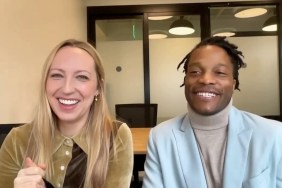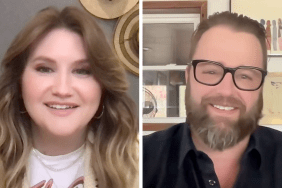
Shrouded in mystery since it was first announced a few years ago, Brad Bird’s Tomorrowland finally hits theaters this Friday, delivering a family adventure that spans generations with a cast headlined by two-time Academy Award winner George Clooney opposite young up and comers Britt Robertson (The Delivery Man, The First Time) and Raffey Cassidy (“Mr Selfridge”). Bird, whose directing credits include The Iron Giant, The Incredibles, Ratatouille and Mission: Impossible – Ghost Protocol, sat down for a brief conversation with ComingSoon.net and, below, you can check out his spoiler-free thoughts on designing the fantastic world of the film alongside Damon Lindelof and Jeff Jensen.
CS: When did the real inception of “Tomorrowland” begin?
Bird: Damon Lindeof was the one who really incepted it. He was talking with Sean Bailey, who was the President of Disney Pictures. They first just asked, “What does the word ‘Tomorrowland’ suggest?’ It’s one of those words that seems to spark people. Why does it spark people and what can you do with it? Other than playing into that word, there was no mandate to tell a certain story or not. Damon brought on Jeff Jensen and they basically spent six months coming up with a backstory of this whole other world. Damon came in and did some very precise story work that I wanted done on “Mission: Impossible.” It was after the movie was basically shot and there was room for just a couple of days of reshoots to adjust some things I wanted fixed. Damon had very little wiggle room, but he was a very precise story surgeon, doing just enough to fix this little thing and that little thing and all the little things that I wanted fixed. I was really impressed with him and we were just talking and having lunch. I asked him what he was doing and he mentioned this project. He started talking about these ideas and was immediately drawn in. They had concocted the iceberg, but the tip that was going to be in the movie was still up for grabs.
CS: Was there a specific aspect or moment that made you realize that you wanted to take the reins?
Bird: I didn’t think of it that heavily, but I always found myself leaning forward when he was talking about it. I thought that was a good sign. If I’m leaning forward, maybe other people will lean forward as well. I think it was the idea of, ‘Why did our vision of the future change?’ I think that’s a really interesting notion. When Damon and I were first talking about it, we were talking about our visions of the future as kids. It seemed not crazy to think about the future being better than it is now. Now that idea is considered sort of quaint. Yet things have been bad and good on the planet of the last hundred years. Before that, there were terrible things happening in the world. People were okay with the idea of a better future and they’re not anymore. It’s now considered naive or quaint or silly to have anything that’s not dark in mind. We kind of looked at each other and went, “Why is that? What changed?” and then we tried to build a fable around that.
CS: One of the fascinating aspects of that fable is just how in-depth it goes. There’s an intensely detailed viral marketing aspect to “Tomorrowland” and I’m curious to know how involved you were in orchestrating its specifics.
Bird: Damon and Jeff love that stuff and they brought me in to play in that particular sandbox. Certainly, “Lost” had a lot of that stuff in it. Damon’s very comfortable with that while I’m a bit new to it. I did the animated one and I participated in this World’s Fair commercial that’s out there now. I wrote that, using archival footage. So I can have fun with those kind of things. We did “Mr. Incredible and Friends,” which was a really cheap animated cartoon that had been lost in “The Incredible” universe. That’s on the DVD. I can play in those ways, but that’s an arena that Damon and Jeff are really comfortable in.
CS: There’s a very impressive cast at the center of “Tomorrowland,” including Raffey Cassidy as Athena. Was it a challenge to find someone so talented that young?
Bird: She came in out of outer space. We had this very difficult task of casting this character. She had to be both wise and not jaded. She had to be a child. How do you depict that all in one thing? We could find kids that were positive and kind of happy, but they didn’t have any depth. They didn’t feel like old souls. Then we found lots of kids that felt like wise old souls, but they had this cynical edge. They were 11 going on 47. Raffey just kind of popped in out of the blue. We had this little test scene out there and her father shot her doing the test scene. He sent two or three takes of her doing it, just shot on his iPhone and sent over the line. We looked at it and, at the beginning and end of each take, she gave this big thumbs up. We saw that and knew that was the character. That was Athena. We got incredibly lucky. She’s amazing and both she and Britt are going to have very long careers.
CS: In the comic book store sequence, there’s quite a few shout-outs to some of your previous films…
Bird: And a lot of films that I didn’t work on but that I love.
CS: It seems like, in a lot of ways, the comic shop is a microcosm of the idea of Tomorrowland itself. A place that you can fill with ideas and concepts you love. When it came to building the sci-fi elements of Tomorrowland, was there a particular element that launched the world for you?
Bird: It’s weird because, when you first start a project, the sky’s the limit. You have an idea, but you’re trying to be open to anything and everything. You think of oceans of cool ideas and then you gradually sober up and you realize that the story needs to what dictates which ideas survive. The question is always, “How useful is this to the story?” Basically, you have this pile of cool things and you want to get them into the balloon. The balloon won’t get off the ground, though, until you start pitching these things away. A lot of the stuff that you’re throwing out is stuff that you love, but eventually you’re aloft. The things that are left are the things that kind of come into being. I was intrigued by notions that we couldn’t explore that much in the movie, too. That’s when you look at a city like Chicago. Chicago has been very wise about what buildings it has retained. Half of the cool buildings that have been built in LA are gone. They lose interest in them after 20 years and blow them away with no appreciation for the fact that they’re amazing. Chicago seems to know that this building is a classic and they save that. Then this building maybe is not a classic. Outta here! Then they build something new. It’s a skyline full of really amazing buildings and it’s getting better all the time. If you imagine a futuristic city and imagine it being built over a long period of time, it’s all futurism, but it’s futurism from the end of the 19th century when it was all about wrought iron. Some of it is from the 1920s when Hugh Ferriss had these buildings that were blocks, wide at the base. They were just these giant monoliths with curved edges. In the 1930s it was Raymond Loewy and streamline, right before the war kind of took away that vision of the future. There’s Bauhaus and these other things from that era that, even though they were designed in the 20s, still look modern. If all of those were existing side by side the way they do in Chicago, it’s all futurism, but from many different decades. What would that look like? What would that feel like? We touch upon that. There’s the city that’s being built in the ’60s when young Frank takes his jet pack flight and then there’s the vision that Casey sees when she touches it. That has a bit more of an ’80s flavor because that’s when they were about to come out with the pin in 1984. They were preparing to present the future then. That has an ’80s feel to it. No one says anything like, “This looks really ’80s,” but that’s the idea behind it. Having multiple visions of the future was interesting to me.
CS: I wanted to ask about the Walt Disney connection, too. He’s never actually mentioned in the film, but a lot of themes seems to grow out his philosophy for the park.
Bird: Tomorrowland, as a concept, was always really interesting to me because it’s the only part of Disneyland that was designed to continually go out of date and continually have to be reinvented. It’s the kind of thing that a businessman would find very frustating. “Why do I have to keep rebuilding this! I want to be done with it!” Walt Disney, though, looked at that as a wonderful aspect. He wanted to figure out what’s next. What’s coming? Tomorrowland is not a long time ago in a galaxy far, far away. It’s what’s coming. It’s meant to be fantastic, but it’s not meant to be a fantasy. It’s the fantastic that’s right around the corner. I think that’s a wonderful thing to have people visit and be surrounded by. I think it prepares their minds for what the future can be and asks how we get there.
Tomorrowland opens in theaters on Friday, May 22.
Tomorrowland
-
Tomorrowland

Disney's TOMORROWLANDCasey (Britt Robertson) Ph: Film Frame©Disney 2015
-
Tomorrowland

Disney's TOMORROWLAND...Casey (Britt Robertson) ..Ph: Film Frame..©Disney 2015
-
Tomorrowland

Disney's TOMORROWLANDDavid Nix (Hugh Laurie) Ph: Film Frame©Disney 2015
-
Tomorrowland

Disney's TOMORROWLANDCasey (Britt Robertson) Ph: Film Frame©Disney 2015
-
Tomorrowland

Disney's TOMORROWLAND..Frank Walker (George Clooney)..Ph: Film Frame..©Disney 2015
-
Tomorrowland

Disney's TOMORROWLAND..Athena (Raffey Cassidy)..Ph: Kimberley French..©Disney 2015
-
Tomorrowland

Disney's TOMORROWLAND..Casey (Britt Robertson)..Ph: Film Frame..©Disney 2015
-
Tomorrowland

Disney's TOMORROWLAND..Frank Walker (George Clooney)..Ph: Film Frame..©Disney 2015
-
Tomorrowland

Disney's TOMORROWLAND.. Casey's Dad (Tim McGraw)..Ph: Kimberley French..©Disney 2015
-
Tomorrowland

Disney's TOMORROWLAND..Casey (Britt Robertson) ..Ph: Kimberley French..©Disney 2015
-
Tomorrowland

Disney's TOMORROWLAND..Frank Walker (George Clooney)..Ph: Kimberley French..©Disney 2015
-
Tomorrowland

Disney's TOMORROWLAND..Young Frank (Thomas Robinson)..Ph: Kimberley French..©Disney 2015
-
Tomorrowland

Disney's TOMORROWLAND..Athena (Raffey Cassidy)..Ph: Kimberley French..©Disney 2015
-
Tomorrowland

Disney's TOMORROWLAND..Young Frank Walker (Thomas Robinson) ..Ph: Film Frame..©Disney 2015
-
Tomorrowland

Disney's TOMORROWLAND..Casey (Britt Robertson)..Ph: Film Frame..©Disney 2015
-
Tomorrowland

Disney's TOMORROWLAND..L to R: Young Frank (Thomas Robinson) & Athena (Raffey Cassidy)..Ph: Kimberley French..©Disney 2015
-
Tomorrowland

Disney's TOMORROWLAND..Young Frank Walker (Thomas Robinson) ..Ph: Film Frame..©Disney 2015
-
Tomorrowland

Disney's TOMORROWLAND..Young Frank Walker (Thomas Robinson) ..Ph: Film Frame..©Disney 2015
-
Tomorrowland

Disney's TOMORROWLAND..Casey (Britt Robertson) ..Ph: Kimberley French..©Disney 2015
-
Tomorrowland

Disney's TOMORROWLAND..Tomorrowland pin ..Ph: Kimberley French..©Disney 2015
-
Tomorrowland

-
Tomorrowland

-
Tomorrowland

-
Tomorrowland

-
Tomorrowland

-
Tomorrowland

-
Tomorrowland

-
Tomorrowland

-
Tomorrowland

-
Tomorrowland

-
Tomorrowland

-
Tomorrowland

-
Tomorrowland

-
Tomorrowland









